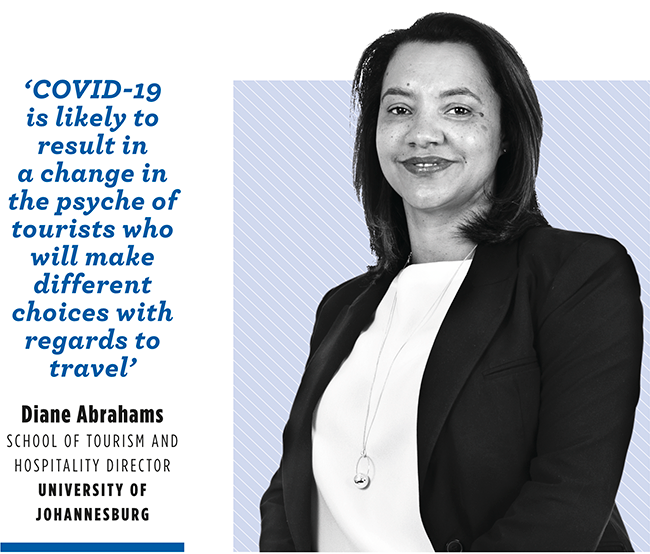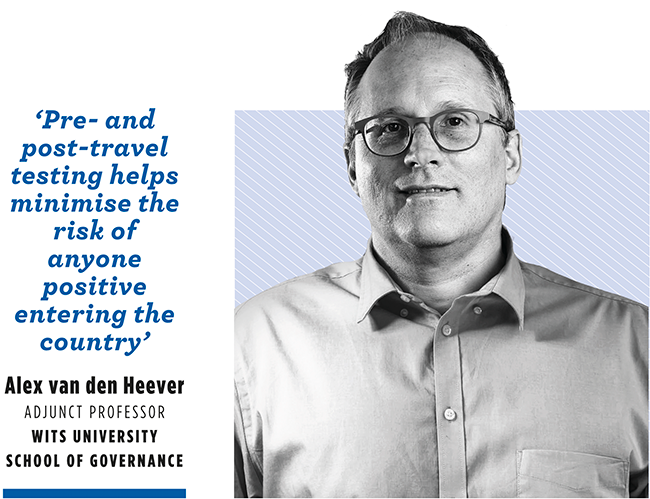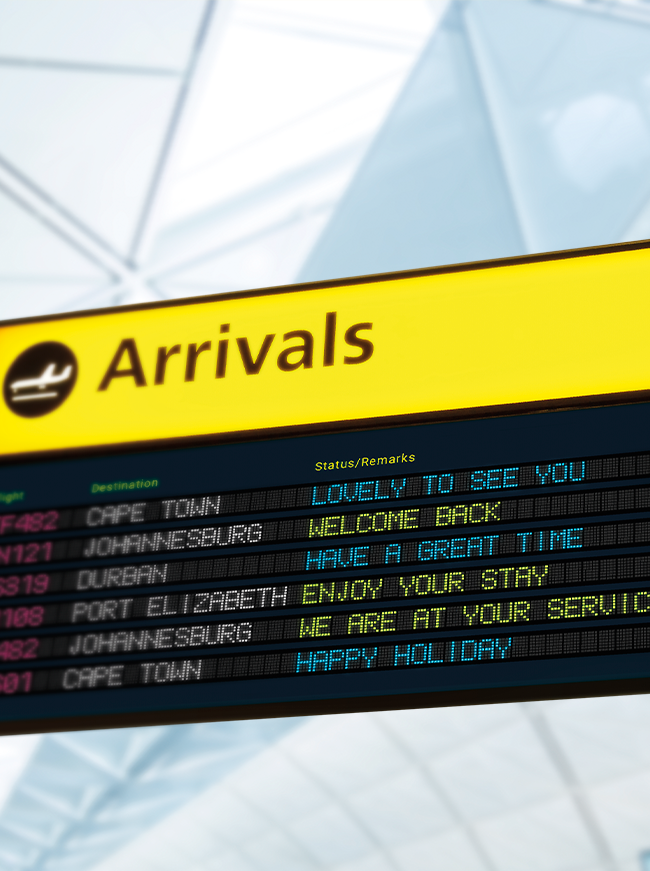The red carpet is being rolled out for local travellers who are getting to know SA from a perspective that has historically been reserved for overseas tourists. Bespoke wildlife safari? Gourmet dining? Time-out at a boutique hotel? Certainly. At your service…
The hospitality and tourism industry – which has been ravaged by COVID-19 and the national lockdown with its travel restrictions, border closures and alcohol ban – has started its recovery by courting domestic travellers. It’s pulling out everything to claw back some of the losses that struck the sector over the past months. An estimated R54.2 billion in output may already have been lost between the start of the lockdown in late March and the end of May 2020, according to South African Tourism. In its recovery plan document, the national tourism body warned that the sector could potentially suffer a 75% revenue reduction in 2020, putting a further R149.7 billion in output, 438 000 jobs and R80.2 billion in foreign receipts at risk.
Yet there’s hope amid this situation. The UIF-TERS (Unemployment Insurance Fund’s Temporary Employee Relief Scheme) has proved to be a lifesaver for companies of all sizes, including JSE-listed hotel group Tsogo Sun. In the same vein, the state’s R200 million Tourism Relief Fund assisted many SMEs with up to R50 000 (about 58% of industry players generate less than R5 million annual revenue, with 70% of accommodation and hospitality companies in this bracket, according to the Tourism Business Council of South Africa [TBCSA]).

Tourism has been identified as a priority sector in the government’s plan to resuscitate the economy, because of its ability to rapidly create employment, notably large numbers of entry-level jobs (cleaners, waiting staff and drivers, among many others). On top of this – and in addition to being the economy’s second-most significant export sector – tourism is a catalyst for geographic diversification. ‘The feedback I have been receiving from the sector is that domestic tourism has helped to put many tourism businesses back into operation and many jobs are being recovered in the sector,’ said Mmamoloko Kubayi-Ngubane, Minister of Tourism, in October. ‘More businesses and jobs will be recovered when international travel goes to full recovery.’
Until then, ‘aggressive’ domestic tourism campaigns continue to encourage South Africans to travel and explore their own country, while adhering to COVID-19 safety protocols. Those who still have money at their disposal can expect personal attention at a fraction of the standard rates. Budgets have been slashed – from small bed-and-breakfasts to mega hotels. Admittedly, prices at the high end are still eye-watering, but now is the time for bucket-list items such as private game viewing at a luxury game lodge or a journey on the world-famous Blue Train. Incidentally, the latter goes for R12 700 per person, down from R23 000, until 1 April 2021 for an all-inclusive two-day rail trip plus domestic flight.
Even in the absence of visitors from the UK, Germany, the US and other key source markets, high-end tourism providers can still find wealthy clients locally. Sisa Ntshona, CEO of SA Tourism, gives the example of South Africans who used to travel overseas and are now spending their holidays here. ‘Ultimately the lures of supply and demand will prevail,’ he said in a recent TV interview. ‘Businesses need to level their value proposition accordingly, so for instance while having three meals a day consisting of four courses each may be appropriate for the international traveller, they may need to adjust this for the local consumer.’ Ntshona anticipates the tourism recovery to take two-and-a-half to three years to revert to 2019 levels. Leading this from the inside out, the process began with the domestic market, followed by regional sub-Saharan Africa (mostly via land borders) and, more recently, with international air travellers.
The gradual opening of sub-sectors forms part of a recovery strategy to ‘protect and rejuvenate supply, reignite demand and strengthen enabling capability’. The recovery plan envisions structurally transforming the sector to include a broader base of travellers and turn SA into a globally competitive post-pandemic destination. ‘COVID-19 has reordered what we know of tourism and requires an important mindset shift by the tourism sector,’ according to Diane Abrahams, director at the University of Johannesburg’s School of Tourism and Hospitality. ‘A new form of travelling that prioritises social distancing, avoiding crowded places – such as nature-based options like game reserves, hiking trails, botanical gardens, and so on – has grown tremendously as the consumer is now more aware of health and safety considerations. The response to reviving the tourism economy therefore has to include a low-touch, high-tech option. Hotels are already using smart technology that minimises contact between guests and hotel staff. [They] have also adapted by having more pre-packed meals for guests and limiting seating in restaurants.’ She explains that another big COVID-related change is the shift in mobilities. ‘Those who choose to travel now opt for greater use of private car, rental vehicles or camper vans. This will have a significant role in terms of the transport and tourism relationship.’
SA Tourism stats show that ‘transport and related services’ is the sub-sector that contributes most to industry employment (34%) and second-highest to industry output (27%), after ‘support and indirect services’ (37%). After lobbying for the opening of international air travel, the tourism industry welcomed the scrapping of government’s ‘red list’ of high-risk countries. In November, international arrivals could enter SA on presenting a negative COVID-19 test not older than 72 hours from departure.

‘We are excited by the full opening of our international borders because this is a strong testament to the fact that we are open for both business and leisure travel. This opening brings certainty for South Africa as a travel destination, putting us back on the map and on the radar for many travellers who want to come explore our beautiful country,’ said SA Tourism’s Ntshona, although he didn’t expect ‘an immediate influx of tourists’. And indeed, shortly after the travel relaxation there was ‘no noticeable presence of international visitor arrivals to speak of’ at SA’s most-visited tourist attraction, the V&A Waterfront in Cape Town. And, of course, the country remains at the mercy of ever-shifting regulations. Waterfront head of communications Donald Kau expects this trend to remain the case as a second wave of COVID-19 sweeps the world, resulting in more national lockdowns.‘Our daily footfall numbers [at end-2020 were] on average 25 000 visitors at the start of the week and peaking around 50 000 on the weekends. This is down from average of 70 000 to 80 000 visitors per day that we were experiencing before COVID-19.’
To help struggling small businesses in the precinct over the toughest times, the Waterfront has been running an SMME Support Hub and provided R15 million in rental relief to 270 direct tenants. To rebuild confidence among visitors and staff, the precinct has ramped up its technology to introduce ‘click and collect’ drive-through shopping solutions, contactless parking payment and a drive-through COVID testing facility. It became the country’s first attraction to receive the World Travel and Tourism Council (WTTC) Safe Travels stamp – a global accolade specifically designed to address the coronavirus health and hygiene protocols. ‘COVID-19 is likely to result in a change in the psyche of tourists who will make different choices with regard to travel,’ says Abrahams. ‘Their intention to travel in the future will be influenced by “perceived risk”.
Overall tourism demand usually decreases under circumstances of perceived risk, which includes natural disasters, political instability, terrorism and, now, the COVID-19 pandemic. ‘Top of mind for any international traveller would be that the destination is safe and all the right protocols are in place in line with international standards. South Africa has been widely regarded as having dealt with the pandemic relatively well when compared to some developed countries and this should stand the country in good stead.’
Her fellow academic Alex van den Heever, adjunct professor at Wits University’s School of Governance, says that ‘pre- and post-travel testing helps minimise the risk of anyone positive entering the country. Civil-aviation protocols also minimise the risk of further transmission if someone positive does travel. When present in the country the tourist industry has implemented health protocols to minimise the risk of transmission on their premises. Outside of tourist accommodation, the risks are the same as for domestic tourists and residents’.

The TBCSA’s Travel Safe – Eat Safe certification has received the WTTC’s stamp of approval and signals visitors that the health screening, distancing and cleaning procedures are in place at participating restaurants, guest houses and other businesses. The programme app also facilitates contact tracing. Marc Wachsberger, MD of Capital Hotels and Apartments, blamed ‘fear mongering’ and misinformation via social media for damaging traveller confidence, adding that when there were rumours of another impending hard lockdown, their bookings immediately ‘fell off the cliff’. The group managed to retain most of its 550 employees during the pandemic, open two new hotels (in Pretoria and Sandton), refurbish another one (in Sandton) while starting construction on another one (in Nelspruit).
‘We learnt quickly that we needed to adapt to the reality on the ground,’ he said. ‘We pivoted to host quarantine and essential services, so by the time the industry reopened, the sanitising protocols were the new normal for us. We then pivoted to the leisure segment: Joburgers in Joburg, Pretorians in Pretoria, who were ready for a break by the pool and team building in our hotels, which we call “sanitised sanctuaries”. ‘We’re seeing it loud and clear in our bookings that the corporates are coming back in February 2021,’ says Wachsberger, noting a demand for conferences, only that now they needed to be a combination of in-person and virtual meetings. Such hybrid events will increasingly become the norm as the sector adapts, says Abrahams. ‘Overall, the shift for the SA tourism sector will be the move to more inclusive, affordable domestic tourism that makes greater use of innovation and smart technology as part of the recovery and re-igniting of the tourism sector.’
Meanwhile, preparations are under way for a major foreign-currency earner: the impending British and Irish Lions rugby tour. The overseas contingent of match tickets for July and August 2021 was sold out quickly, leaving hoteliers, restaurateurs and related businesses across SA with the hope that, despite all the uncertainty, better times may lie just ahead.








